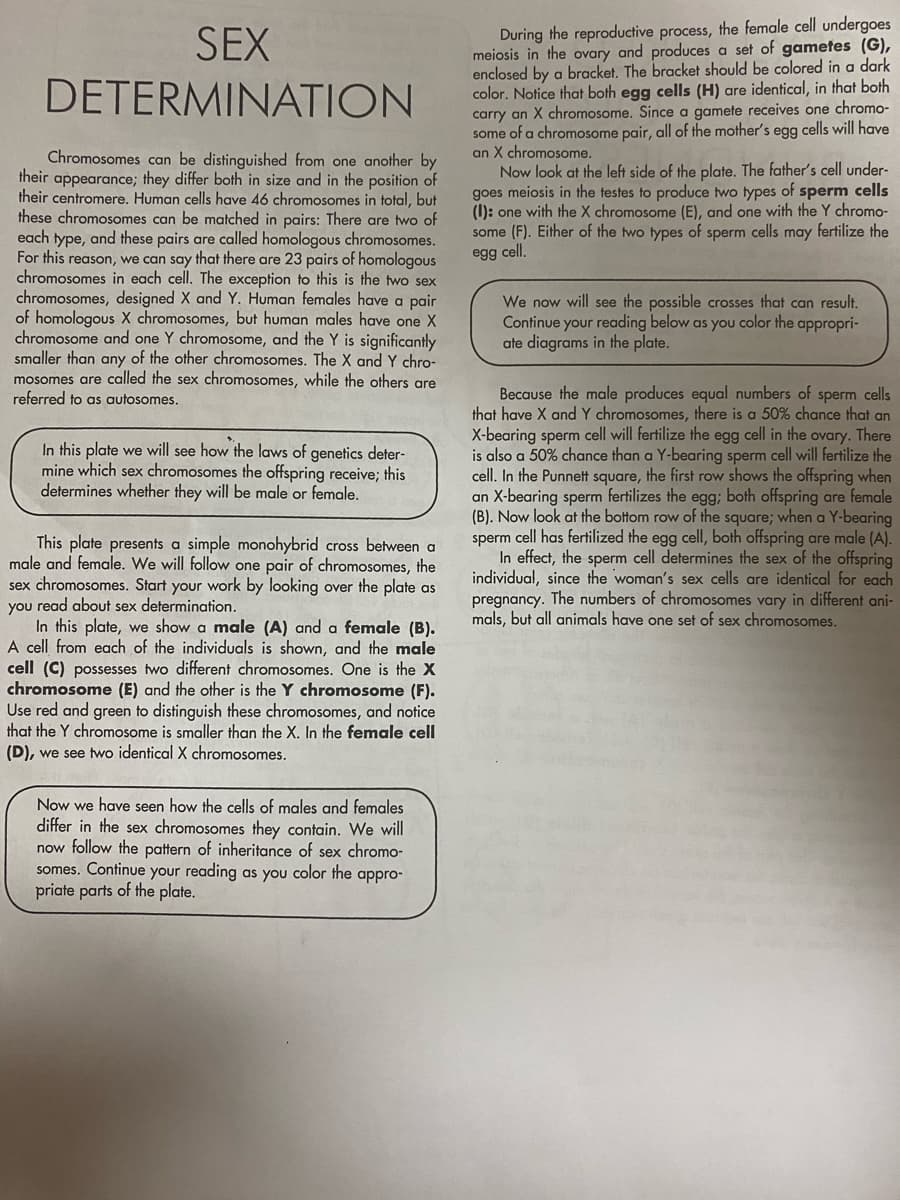Human Physiology: From Cells to Systems (MindTap Course List)
9th Edition
ISBN:9781285866932
Author:Lauralee Sherwood
Publisher:Lauralee Sherwood
Chapter20: The Reproductive System
Section: Chapter Questions
Problem 11RE
Related questions
Question
Please tell what to color for each parts

Transcribed Image Text:During the reproductive process, the female cell undergoes
meiosis in the ovary and produces a set of gametes (G),
enclosed by a bracket. The bracket should be colored in a dark
color. Notice that both egg cells (H) are identical, in that both
carry an X chromosome. Since a gamete receives one chromo-
some of a chromosome pair, all of the mother's egg cells will have
an X chromosome.
Now look at the left side of the plate. The father's cell under-
goes meiosis in the testes to produce two types of sperm cells
(I): one with the X chromosome (E), and one with the Y chromo-
some (F). Either of the two types of sperm cells may fertilize the
SEX
DETERMINATION
Chromosomes can be distinguished from one another by
their appearance; they differ both in size and in the position of
their centromere. Human cells have 46 chromosomes in total, but
these chromosomes can be matched in pairs: There are two of
each type, and these pairs are called homologous chromosomes.
For this reason, we can say that there are 23 pairs of homologous
chromosomes in each cell. The exception to this is the two sex
chromosomes, designed X and Y. Human females have a pair
of homologous X chromosomes, but human males have one X
chromosome and one Y chromosome, and the Y is significantly
smaller than any of the other chromosomes. The X and Y chro-
mosomes are called the sex chromosomes, while the others are
referred to as autosomes.
egg cell.
We now will see the possible crosses that can result.
Continue your reading below as you color the appropri-
ate diagrams in the plate.
Because the male produces equal numbers of sperm cells
that have X and Y chromosomes, there is a 50% chance that an
X-bearing sperm cell will fertilize the egg cell in the ovary. There
is also a 50% chance than a Y-bearing sperm cell will fertilize the
cell. In the Punnett square, the first row shows the offspring when
an X-bearing sperm fertilizes the egg; both offspring are female
(B). Now look at the bottom row of the square; when a Y-bearing
sperm cell has fertilized the egg cell, both offspring are male (A).
In effect, the sperm cell determines the sex of the offspring
individual, since the woman's sex cells are identical for each
pregnancy. The numbers of chromosomes vary in different ani-
mals, but all animals have one set of sex chromosomes.
In this plate we will see how the laws of genetics deter-
mine which sex chromosomes the offspring receive; this
determines whether they will be male or female.
This plate presents a simple monohybrid cross between a
male and female. We will follow one pair of chromosomes, the
sex chromosomes. Start your work by looking over the plate as
you read about sex determination.
In this plate, we show a male (A) and a female (B).
A cell from each of the individuals is shown, and the male
cell (C) possesses two different chromosomes. One is the X
chromosome (E) and the other is the Y chromosome (F).
Use red and green to distinguish these chromosomes, and notice
that the Y chromosome is smaller than the X. In the female cell
(D), we see two identical X chromosomes.
Now we have seen how the cells of males and females
differ in the sex chromosomes they contain. We will
now follow the pattern of inheritance of sex chromo-
somes. Continue your reading as you color the appro-
priate parts of the plate.

Transcribed Image Text:O O O
Male
Female Cell
Gametes
A.
D.
Female
B.
Male Cell
X Chromosome
E.
Y Chromosome
F.
Egg Cell
Sperm Cell I
Expert Solution
This question has been solved!
Explore an expertly crafted, step-by-step solution for a thorough understanding of key concepts.
Step by step
Solved in 2 steps with 1 images

Knowledge Booster
Learn more about
Need a deep-dive on the concept behind this application? Look no further. Learn more about this topic, biology and related others by exploring similar questions and additional content below.Recommended textbooks for you

Human Physiology: From Cells to Systems (MindTap …
Biology
ISBN:
9781285866932
Author:
Lauralee Sherwood
Publisher:
Cengage Learning

Biology Today and Tomorrow without Physiology (Mi…
Biology
ISBN:
9781305117396
Author:
Cecie Starr, Christine Evers, Lisa Starr
Publisher:
Cengage Learning

Biology 2e
Biology
ISBN:
9781947172517
Author:
Matthew Douglas, Jung Choi, Mary Ann Clark
Publisher:
OpenStax

Human Physiology: From Cells to Systems (MindTap …
Biology
ISBN:
9781285866932
Author:
Lauralee Sherwood
Publisher:
Cengage Learning

Biology Today and Tomorrow without Physiology (Mi…
Biology
ISBN:
9781305117396
Author:
Cecie Starr, Christine Evers, Lisa Starr
Publisher:
Cengage Learning

Biology 2e
Biology
ISBN:
9781947172517
Author:
Matthew Douglas, Jung Choi, Mary Ann Clark
Publisher:
OpenStax

Human Heredity: Principles and Issues (MindTap Co…
Biology
ISBN:
9781305251052
Author:
Michael Cummings
Publisher:
Cengage Learning

Biology: The Dynamic Science (MindTap Course List)
Biology
ISBN:
9781305389892
Author:
Peter J. Russell, Paul E. Hertz, Beverly McMillan
Publisher:
Cengage Learning

Concepts of Biology
Biology
ISBN:
9781938168116
Author:
Samantha Fowler, Rebecca Roush, James Wise
Publisher:
OpenStax College